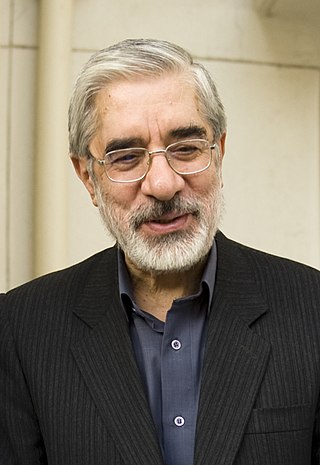The Iranian Green Movement or Green Wave of Iran,also referred to as the Persian Awakening or Persian Spring by the western media,refers to a political movement that arose after the June 12,2009 Iranian presidential election and lasted until early 2010,in which protesters demanded the removal of Mahmoud Ahmadinejad from office. Green was initially used as the symbol of Mir Hossein Mousavi's campaign,but after the election it became the symbol of unity and hope for those asking for annulment of what they regarded as a fraudulent election. Mir Hossein Mousavi and Mehdi Karroubi are recognized as political leaders of the Green Movement. Grand Ayatollah Hossein-Ali Montazeri was also mentioned as spiritual leader of the movement.

Mohammad Khatami is an Iranian reformist politician who served as the fifth president of Iran from 3 August 1997 to 3 August 2005. He also served as Iran's Minister of Culture from 1982 to 1992. Later,he was critical of the government of subsequent President Mahmoud Ahmadinejad.

The Guardian Council is an appointed and constitutionally mandated 12-member council that wields considerable power and influence in the Islamic Republic of Iran.

Grand Ayatollah Hussein-Ali Montazeri was an Iranian Shia Islamic theologian,Islamic democracy advocate,writer and human rights activist. He was one of the leaders of the Iranian Revolution and one of the highest-ranking authorities in Shīʿite Islam. He was once the designated successor to the revolution's Supreme Leader,Ayatollah Khomeini,but they had a falling-out in 1989 over government policies that Montazeri claimed infringed on people's freedom and denied them their rights,especially after the 1988 mass execution of political prisoners. Montazeri spent his later years in Qom and remained politically influential in Iran,but was placed in house arrest in 1997 for questioning "the unaccountable rule exercised by the supreme leader",Ali Khamenei,who succeeded Khomeini in his stead. He was known as the most knowledgeable senior Islamic scholar in Iran and a grand marja of Shia Islam. Ayatollah Montazeri was said to be one of Khamenei's teachers.

The Islamic Iran Participation Front was a reformist political party in Iran. It was sometimes described as the most dominant member within the 2nd of Khordad Front.

The Reformists are a political faction in Iran. Iran's "reform era" is sometimes said to have lasted from 1997 to 2005—the length of President Mohammad Khatami's two terms in office. The Council for Coordinating the Reforms Front is the main umbrella organization and coalition within the movement;however,there are reformist groups not aligned with the council,such as the Reformists Front.

Presidential elections were held in Iran 17 June 2005,with a second round run-off on 24 June. Mohammad Khatami,the outgoing president of Iran,stepped down on 2 August 2005,after serving his maximum two consecutive four-year terms according to the Islamic republic's constitution.

Mir-Hossein Mousavi Khameneh is an Iranian reformist politician,artist and architect who served as the 49th and last Prime Minister of Iran from 1981 to 1989. He was a reformist candidate for the 2009 presidential election and eventually the leader of the opposition in the post-election unrest. Mousavi served as the president of the Iranian Academy of Arts until 2009,when conservative authorities removed him. Although Mousavi had always considered himself a reformist and believed in promoting change within the 1979 Revolution constitution,on 3 Feb 2023,in response to the violent suppression of Iranians by Ali Khamenei,the Supreme Leader of Iran,he announced opposition to the Islamic Republic constitution and asked for a widespread referendum to fully change the constitution and make a fundamental change in Iran's political system.

Mohammad Reza Aref is an Iranian engineer,academic and reformist politician who was the parliamentary leader of reformists' Hope fraction in the Iranian Parliament,representing Tehran,Rey,Shemiranat and Eslamshahr. Aref has also been heading the Reformists' Supreme Council for Policymaking since its establishment in 2015. He is currently member of the Expediency Discernment Council.

Semirom is a city in the Central District of Semirom County,Isfahan province,Iran,serving as capital of both the county and the district.

Eshaq Jahangiri Kouhshahi is an Iranian politician who served as the sixth first vice president from 2013 until 2021 in Hassan Rouhani's government. Jahangiri was the minister of industries and mines from 1997 to 2005 under President Mohammad Khatami. Before that,he was the governor of Isfahan Province. He was also a member of Parliament for two terms.

Mir-Hossein Mousavi Khameneh served as the last Prime Minister of Iran,from 1981 to 1989,before the position was abolished in the 1989 review of the Iranian constitution. In the years leading up to the Islamic Revolution,Mousavi and his wife,Zahra Rahnavard,moved to the United States;they returned to Iran shortly after the establishment of the Islamic Republic.

The Ashura protests were a series of protests which occurred on 27 December 2009 in Iran against the outcome of the June 2009 Iranian presidential election,which demonstrators claim was rigged. The demonstrations were part of the 2009 Iranian election protests and were the largest since June. In December 2009,the protests saw an escalation in violence.

Muhammad Khatami's tenure as the fifth president of Iran began with his inauguration on 3 August 1997 to 3 August 2005.













